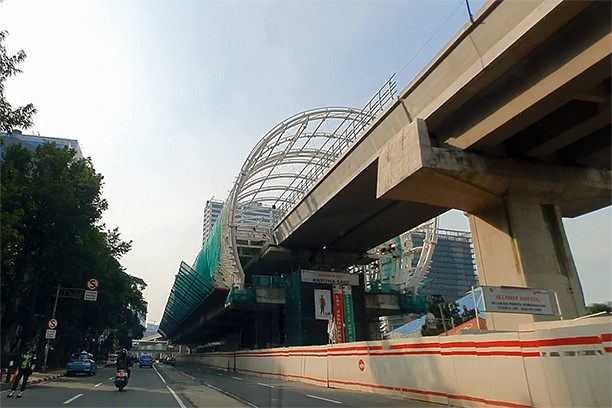Popular Reads
Top Results
Can't find what you're looking for?
View all search resultsPopular Reads
Top Results
Can't find what you're looking for?
View all search resultsBanking update: Strategy to support economic recovery
Many of the latest macroeconomic indicators suggest that we will have a sharp contraction in the last quarter.
Change text size
Gift Premium Articles
to Anyone
A
t the time I started writing this article, we were still waiting for the release of second-quarter GDP data scheduled to be announced Wednesday. The economy experienced a sharp slowdown in the first quarter of this year to growth of 2.97 percent year-on-year (yoy), from 4.97 percent in the preceding quarter. It is almost certain that Indonesia experienced a negative year-over-year growth in the second quarter due to the social distancing policy to curb the COVID-19 pandemic.
Many of the latest macroeconomic indicators suggest that we will have a sharp contraction in the last quarter. Tax revenue in June contracted by more than 9.3 percent. At the same time, motor vehicle sales, cement consumption and capital goods imports contracted by staggering numbers of 86 percent, 57 percent and 36 percent yoy, respectively. Based on those numbers, we predict a second-quarter domestic GDP contraction of more than 6 percent, the worst quarterly GDP growth since the first quarter of 1999.
Slowing economic activity is having a significant impact on the banking industry. Loan growth, as of May 20, decelerated to only 3.0 percent yoy, the lowest rate since June 2002, and it might continue to weaken in the months to come. Meanwhile, the nonperforming loan (NPL) ratio has exceeded 3 percent for the first time since August 2017. Conditions are likely to worsen if the economy does not recover soon.
The government, Financial Services Authority (OJK) and Bank Indonesia have taken a number of extraordinary measures to counter the economic impact of the pandemic on the banking industry. The government policy focuses on stimulus to increase loan issuance, while the OJK’s policy mostly focuses on loan quality and BI focuses on liquidity. The government has placed funds in regional development banks amounting Rp 11.5 trillion (US$791.32 million) to increase loans in provinces hit hard by the pandemic.
Previously, the government placed Rp 30 trillion in state-owned banks. The latest stimulus measures are given by guaranteeing up to 60 percent new working capital loans worth of Rp 100 trillion for labor intensive business. This loan guarantee is higher (80 percent of working capital loans) for priority sectors that have been impacted the most by the pandemic, such as tourism, hotel and restaurant, automotive, textiles and textiles products, electronics, processed wood, furniture and paper products.
The government expects this policy to create additional loans of Rp 100 trillion and prevent layoffs. Meanwhile, the OJK has relaxed rules for banks to manage asset quality.
Liquidity in the banking industry is quite ample, thanks to BI’s quantitative easing (QE) policy. Banks’ placement in BI’s open market operation or monetary policy instruments, which indicates how much banks have in fresh funds, amounted to Rp 449.1 trillion at the end of July, up by a significant Rp 268 trillion from the end of last year.
BI has stated that it has injected Rp 633.24 trillion of additional liquidity into the banking industry through QE, including reserve requirements of around Rp 155 trillion and monetary expansion amounting to Rp 462.4 trillion. The overnight interbank rate, IndONIA, continued to fall to 3.4 percent at the end of last month, which was lowest overnight interbank rate since 2008.
With ample liquidity, low interbank rates and easing pressure in third-party funds competition, banks can lower deposit rates and hence the cost of funds and transmit this to lower loan rates. Furthermore, we still see room for BI to continue to lower the policy rate, as inflation pressure is subdued and the current account deficit is expected to be significantly lower this year compared to last year.
In our opinion, the biggest risk for now is not liquidity but weakening demand for loans and increasing NPL because of the slowing economic growth. It is crucial for banks to maintain stable a NPL ratio during this time of uncertainty.
The reason banks are buying government bonds is that there is no loan demand, while at the same time banks have to mitigate risk to anticipate worsening economic conditions. The government securities are currently seen as the safest and most liquid asset that can be changed to cash immediately through repurchase transactions with BI or in the interbank market if banks need cash.
Banks are still offering debtors affected by COVID-19 loan restructuring arrangements. The OJK stated that, as of mid-July, banks had restructured SME and corporate loans totaling Rp 769.6 trillion (approximately 14 percent of total outstanding loans).
The restructuring process is now near completion, but banks still have to monitor these restructured loans very closely and at the same time increase the provisioning expenses to anticipate losses from the restructuring process. Higher provisioning expenses will have an impact on profitability, but the provisioning is necessary to anticipate a further weakening of asset quality if the OJK relaxation period ends.
Banks have a very important role to play in supporting the national economic recovery program with a precise strategy and by remaining selective in their loan issuance and prudent in their asset quality management.
We have identified a number of promising sectors less impacted by the pandemic, such as agriculture, health, fast-moving consumer goods, information and telecommunication and construction and infrastructure. Banks also need to identify individual debtors outside those industries that have a good repayment capacity, healthy operational cash flow and manageable risk.
Last but not least, banks need to prepare robust risk acceptance criteria, reliable monitoring infrastructure and sufficient internal procedures and regulations in loan disbursement to maintain healthy growth amid economic uncertainties.
-------
Senior financial market analyst at Bank Mandiri










